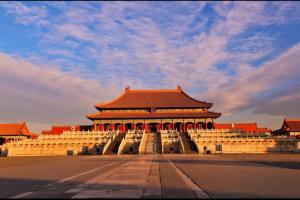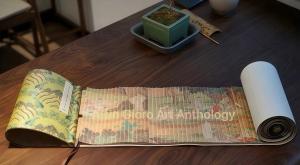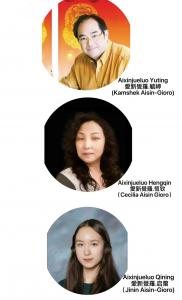The Aisin Gioro International Art Prize Introduces a New Model of Cultural Heritage Through the 24 Solar Terms

The Hall of Supreme Harmony in the Forbidden City illuminated by the spring morning light — its golden roofs and crimson walls embodying both majesty and renewal
The Aisin Gioro International Art Prize reinterprets China’s ancient Solar Terms, bridging tradition and contemporary art.
Unlike conventional art awards that follow fiscal or seasonal cycles, the Aisin Gioro International Art Prize aligns its entire structure — submissions, jury process, exhibitions, and ceremonies — with the poetic rhythm of the Solar Terms. From Lichun (Start of Spring), when entries open, to Qingming (Clear and Bright), when winners are announced, and Bailu (White Dew), when exhibitions unfold, the Prize mirrors nature’s quiet transformations. As the seasons shift, so does the creative pulse of the artists involved.
“This calendar is not just a schedule; it is a cultural gesture,” said Cecilia Aisin Gioro, Founder and Chief Planner of the Prize. “By aligning submission periods with the four seasons in the 24 Solar Terms, we hope artists can rediscover the connection between art and time — because the rhythm of spring and autumn has always been intertwined with life itself, and art can express that continuity in countless ways.”
Her uncle, Dr. Kamshek (Yuting) Aisin Gioro, Co-Founder and Director of Cultural Studies for the Prize, offered a deeper reflection on Chinese heritage:
“To preserve ancient culture, one must not freeze it in time. Only through innovation and engagement with the present can the traditions once abandoned be truly revived and made meaningful again.”
Rooted in the legacy of the Great Qing Dynasty (1636–1912) and the Jurchen ancestry that preceded it, the Aisin Gioro lineage has transitioned from sovereignty to culture. Today, its descendants — artists, scholars, and cultural custodians — interpret heritage not as nostalgia, but as continuity through creativity. “What we inherit is not power, but memory — the memory of beauty and of time,” Cecilia noted.
Chinese art has long been inseparable from its sense of time. The 24 Solar Terms mark the earth’s subtle transformations — its rains, frosts, and renewals — and artists for centuries have responded through symbolic motifs known as the Four Gentlemen: the orchid of spring, the lotus of summer, the chrysanthemum of autumn, and the plum blossom of winter. Each embodies a virtue — grace, purity, endurance, and resilience — forming a visual philosophy of balance and moral clarity.
This aesthetic dialogue continues within the Prize, where artistic creation follows nature’s rhythm: submissions opening at Lichun celebrate new beginnings; the Vernal Equinox invites reflection; Qingming honors remembrance and artistic rebirth; and winter becomes a season of stillness before creativity reawakens. Through this design, art and nature breathe together — time itself becomes a medium of artistic reflection.
Each year’s winning works are compiled into a handcrafted Dragon-Scale Scroll (longlin zhuang), a rare Tang Dynasty–era binding technique that bridges the scroll and codex formats. Pages are layered like scales, allowing the book to unfold or turn seamlessly, symbolizing the continuity of knowledge and art. The only surviving historical example of this craft resides in Beijing’s Palace Museum. By reviving this endangered form, the Prize transforms bookmaking into a dialogue between craftsmanship, memory, and innovation. Each scroll is registered with an ISBN and distributed to museums and archives worldwide — not for sale but as a permanent cultural record.
The Prize’s Youth Divisions in Visual and Sound Arts, founded by Jinin Aisin Gioro (Aixinjueluo Qining) — the youngest co-founder of the Aisin Gioro family — embody the same spirit of renewal. At fourteen, Jinin brings a new voice to the family’s artistic lineage. “Even doodles and quiet sounds have stories,” she says. “If art can heal or comfort someone, it deserves to be heard.” Her words reshaped the Prize’s structure, expanding it into a multigenerational platform that bridges education and creativity. Workshops and mentorships now connect young creators with professional artists, emphasizing empathy, imagination, and responsibility toward culture and community.
The Qingming Festival, when the Prize ceremony is held, symbolizes both remembrance and rebirth — a perfect metaphor for the Aisin Gioro legacy. From the Shenyang Imperial Palace in China to its home base in Vancouver, the Prize connects history with the global present. Behind it stands the Aisin Gioro Arts & Cultural Heritage Society, a registered non-profit organization promoting education, exhibitions, and publications that follow the rhythm of the Solar Terms, positioning Vancouver as a bridge between East and West.
“History is composed of time, and art is how time remembers itself,” said Cecilia Aisin Gioro. “When heritage is retold through creativity, it becomes not nostalgia, but renewal. The horizon of art is not behind us — it lies ahead, in every act of creation.”
Through this cyclical and poetic approach, the Aisin Gioro International Art Prize transforms cultural heritage into a living rhythm — a dialogue between nature and art, ancestry and innovation, remembrance and rebirth.
Xuanzi
AG NEWS
+1 604-764-6665
email us here
Visit us on social media:
LinkedIn
Facebook
YouTube
Legal Disclaimer:
EIN Presswire provides this news content "as is" without warranty of any kind. We do not accept any responsibility or liability for the accuracy, content, images, videos, licenses, completeness, legality, or reliability of the information contained in this article. If you have any complaints or copyright issues related to this article, kindly contact the author above.


